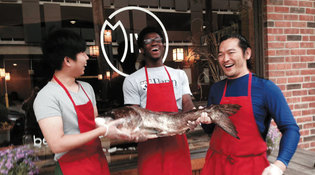 loading
loading
New HavenSushi celebrityBun Lai is making waves with innovative, sustainable food.  Courtesy Miya's SushiRestaurateur Bun Lai (right) introduces Miya’s sustainable food interns Sam Chao (left) and Alfred Tuotol Delle ’17 to the invasive Asian carp. View full imagePicture the humble dandelion. Consider its lowly leaf. Now imagine that leaf, lightly torched, wrapped around rice and burdock roots, seasoned with seaweed and pickled plum: a weed has been magically bestowed with supreme taste and style. Miya’s Sushi restaurant, at 68 Howe Street in downtown New Haven, has led the search for new sushi sensations for over three decades. Its vegetable roll of avocado, cashew cheese, smoked jalapeno, and eggplant is as filling as a sandwich and so flavorful that it needs no soy sauce. “Karma Virtue Chickenots” are a succulent, meatless appetizer—inspired by fried chicken but made of soy, amaranth, and peas and spiced with ginger, sesame, and curry. Miya’s, which will be 35 years old next year, is dedicated to sustainably produced foods and healthy eating. That’s the vision of chef Bun Lai. When Miya’s was founded by Yoshiko Lai—Bun’s mother, who still leads the team at Miya’s—it was thought to be the only sushi bar in Connecticut. “My mom started by catering. Plus, she had a community garden,” Bun recalls. “I was helping—but not really—when I was ten years old.” His father had come to New Haven to do research in ophthalmology at the Yale School of Medicine; the couple divorced years ago. Bun’s sister and brother are also involved in Miya’s. Now in his 40s, Bun has been profiled in National Geographic, Time, the New Yorker, and other magazines for his pioneering work with sustainable food sources and plant-based sushi. He’s developing a TV series in which he visits various communities and prepares meals using locally grown ingredients. He’s also been tapped to play a chef character on a new version of the children’s program Wonderama. New Haven’s sushi superstar has friends who were waiters or regular customers at Miya’s when they were students and who are now ecologists and marine biologists—and who help him locate and harvest new sushi ingredients. Miya’s is known for using invasive species, such as knotweed or Asian carp, as the basis for new entrees. Even the chili peppers in Miya’s distinctive “firecracker sake” are homegrown. When not working at the restaurant, Bun can be found diving for seaweed in Branford or picking plants around his Woodbridge farm. “Foraging is fun for me,” he says. “That’s my playtime.” He brings that playful spirit to work as well. For all its sober, environmentally conscious endeavors, Miya’s is a fun place to eat. You can order seafood sushi rolls named “Rabibaba,” “Oo la la Mitzvah!,” or “Tres Sushi Mariachis.” Veggie roll monikers include “Hot-headed Cowgirl,” “Japafrican Queen,” and “Kiss the Smiling Piggie”—a meat-free mingling of mango chutney, sweet potato, and pine nuts. Drinks are served in Ball jars. The background music can be psychedelic rock or cool jazz. The art on the walls is by local artists, particularly the painter and illustrator Vasilisa Romanenko, who also designed Miya’s menus. Fittingly for a restaurant in a college town, Miya’s offers fine dining experiences but also looks out for impecunious students and budget-conscious gourmands. A section of the menu is headed “Sushi for the Masses,” with a selection of rolls for as little as $5 for five pieces. “When Mom started it,” Bun Lai says, “Miya’s was based on maintaining Japanese traditions, using high-quality ingredients, and being affordable. We still keep to those ideals.” “This is food that can nourish you and fight disease,” he says. “I mean, my mother still eats most of her meals here. This is food I want to feed my mother.”
The comment period has expired.
|
|